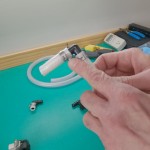This post may contain affiliate links.
This is the fifth installment in our “RV Basics” series, where I try to give you the talks I wish I had gotten when we started RVing. In this one, we’re going to be covering something really fun, and honestly pretty simple, too. Boondocking!
The videos in this series are not (terribly) technical, and are geared towards new RVers. Here, we’ll talk about dry camping in all its forms: boondocking, lot-docking, remote camping, and more. We’ll go over those definitions, give you some tips on how to do them like a pro, and even cover some (hopefully humorous) etiquette tips that will help ensure everybody has a good time. Enjoy!
This series of videos is sponsored by Winnebago, and we’re proud to be partnered with them to bring this to you. I hope it’s all easy enough for anyone to follow, but if it isn’t, let me know!
- In the first video in the series, we cover basic RV electrical systems, here: RV Basics: Understanding RV Electrical Systems for Beginners
- The second video covers freshwater plumbing. It’s right here: RV Basics: Understanding Fresh Water Plumbing for Beginners
- The third video covers wastewater plumbing. That one’s here: RV Basics: Wastewater Plumbing (and Dumping) for Beginners
- And the fourth covers RVing in the winter. You’ll find that one here: RV Basics: Winter RVing for Beginners
If you have questions, let me know below and I’ll do my best to answer!











I do a lot of dry camping and have learned a few things.
–On interstates, truck stops are usually easy to find and have plenty of parking. Often have food and many have showers, propane, dump stations. But you have to be relatively immune to noise (I am).
–I don’t trust iOverlander for urban areas – I have seen several listings that I know are against the rules and some that may get you a ticket or even towed.
–Keep a record of the places you find that you like.
–Be prepared to move if some a*hat shows up. I’ve had a Class-A pull up 10ft from me in a Wallmart lot and put out the slides and fire up some oversized smoke belching diesel generator at 10pm.
–Do not open your door to anyone who comes knocking, open a window. Have pepper spray and know how to use it.
All very excellent tips! Thanks, Graham.
Hi Guys,
Nice tips.
For those of us with no showers, washing dishes is the biggest water sink, certainly using more than half our water. I bet a whole video could address washing dishes efficiently!
There are two times of year when the temps are moderate, but only one of them can you get enuf solar to keep the batteries charged. Dry camping in October/November means you are not getting much solar and to make it worse you are running the lights longer.
You didn’t touch on Stealth Camping, I imagine because it doesn’t apply to Winnebago’s in particular and RVs in general. (Mommy, what is that cool big bus with all the ladders on it?) But, our rig is often mistaken for a amazon delivery van, so we can get away with if. (Wasn’t Lance semi-stealth-able?) In a pinch, we will come to a spot after dark and go completely black, and, at first light, move the rig to a restaurant or just get back on the road. Our favs are un-numbered spaces in big apartment lots. More intentional, we have used the multi-day extended parking at the ends of the DC Metro to visit the Smithsonian in downtown Washington (While it is certainly legal to park there, I am not sure about sleeping in the rig over night). Our most far out spot was in a Ford Dealership, next to another Transit.
Cheers
We never really tried to go “stealth” with Lance – on account of the screaming yellow color and Fit RV logos on the sides… lol.
With our EKKO now, I don’t think we’d have much luck going stealth. But we have stayed in airport long term parking lots before.